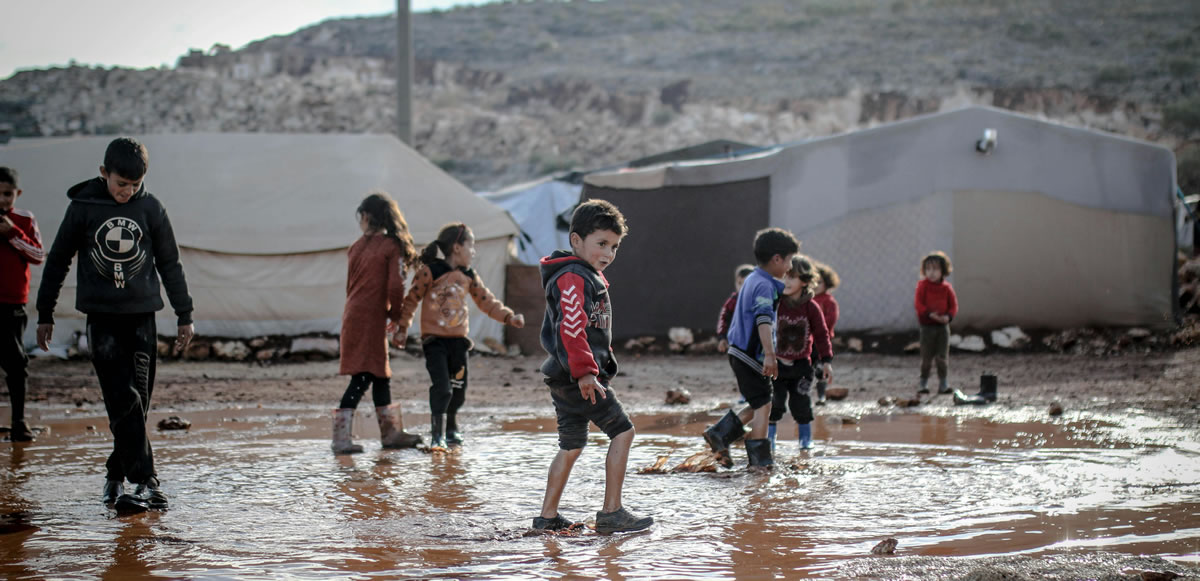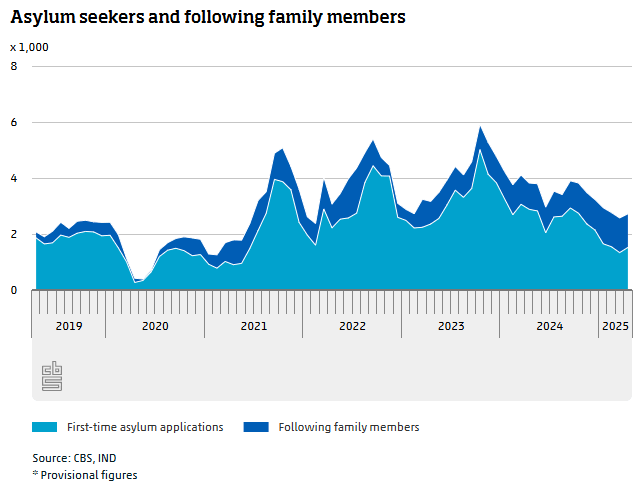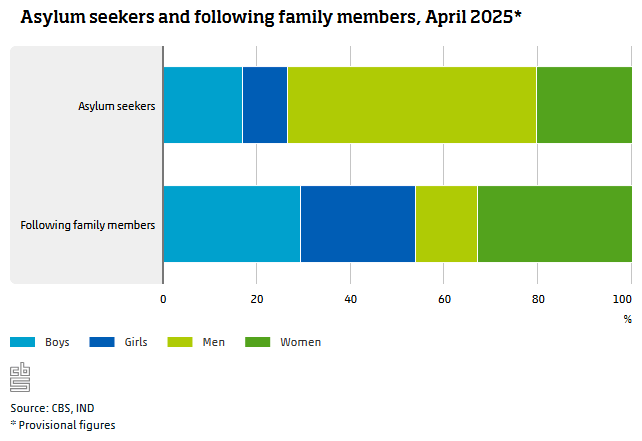
Asylum Policy in the Netherlands
NL
Asylum Policy in the Netherlands: A Comprehensive Analysis
The Netherlands faces mounting pressure over its asylum policy. Political tensions reached a peak in 2024. The Schoof government declared an “asylum crisis” using emergency powers. This decision sparked intense national debate.
Understanding asylum policy requires examining data, history, and current politics. The situation affects thousands of people seeking protection. It also shapes Dutch society and European relations.
June 3, 2025 – The Dutch government has collapsed after Geert Wilders withdrew his far-right party from the governing coalition following a row over migration.
- Over the coming decades, the Dutch population is projected to grow steadily and reach 20.6 million inhabitants by the year 2070. The population is expected to reach 19 million in 2037. The population is growing mainly due to migration and increased life expectancy. By 2040, a quarter of the population will be 65 or older.
Defining Key Terms
Refugees
Refugees are people officially recognized under international law. They fled their home countries due to persecution. The 1951 Geneva Convention protects them. They receive legal status and rights in host countries.
Asylum Seekers
Asylum seekers have applied for protection but await decisions. They submitted requests to remain in a country. Officials review their cases for refugee status. Many live in uncertainty during this process.
Migrants
Migrants move from one country to another for various reasons. Economic opportunities drive many migrations. Climate change also forces people to move. Not all migrants seek asylum or refugee status.
Historical Context
Early Immigration Waves
The Netherlands experienced significant immigration after World War II. Guest workers arrived from Turkey and Morocco in the 1960s. Colonial ties brought people from Indonesia and Suriname. These groups laid foundations for today’s diverse society.
Asylum System Development
The modern asylum system emerged in the 1980s. European cooperation shaped national policies. The Dublin Regulation coordinated asylum procedures across Europe. The Netherlands implemented EU-wide standards and practices.
Recent Trends (2000-2020)
Asylum applications fluctuated significantly over two decades. The 2015 migration crisis brought 44,000 asylum seekers. Numbers dropped to around 20,000 annually by 2018. Syrian refugees formed the largest group during peak years.
Current Statistics and Data
Historical Trends (2000-2024)
Asylum applications in the Netherlands fluctuated dramatically over two decades. The peak occurred in 2015 with 44,000 asylum seekers. Numbers dropped significantly after 2016 to around 20,000 annually. 2024 figures show between 49,800 and 78,500 total asylum seekers.
The 2015 European migration crisis marked a turning point. Syrian refugees dominated applications during this period. Numbers stabilized between 2018-2020 before recent increases. Current levels remain below the 2015 peak.
2024 Asylum Numbers
Between 49,800 and 78,500 people sought asylum in 2024. This includes new applications and family reunifications. The number represents the lowest level since 2020. It matches figures from 2022 and 2023.
Monthly asylum influx in January 2024 reached 4,356 people. This decreased from December 2023’s 4,866 applications. The trend shows seasonal variations throughout the year.
2025 Asylum Numbers
In April 2025, altogether 1,520 asylum seekers arrived in the Netherlands. This is 185 more than in the previous month. In addition, 1,200 following family members arrived, 40 more than in March 2025. In total, 44,055 asylum seekers and following relatives entered the country in 2024. The number of asylum migrants peaked in 2015, when the war in Syria caused a large influx of refugees. Subsequently, the number of following family members peaked in the last quarter of 2016 and the first two quarters of 2017.

Gender Demographics
Gender patterns reveal significant male dominance in asylum applications. Three quarters of asylum seekers submitting their first asylum application in 2023 were men. This pattern remains consistent across recent years.
Syrian and Yemeni asylum seekers show even higher male percentages. The percentage was higher among those from Syria and Yemen, at 84 and 83 percent respectively. These figures reflect dangerous migration routes favoring young men.
Historical data from 2015 shows similar patterns. The majority of the asylum seekers in 2015 were male (32,825) and older than 18 years (34,435). Adult males consistently represent the largest demographic group.
Women represent approximately 25% of asylum applications in recent years. Female asylum seekers often face different challenges including gender-based persecution. Many women arrive through family reunification rather than initial asylum applications.
Age distribution skews young across all gender categories. The majority of asylum seekers were under the age of 35 when applying for asylum. This reflects global migration patterns where younger people more readily undertake dangerous journeys.
The group of asylum seekers in April 2025 consisted of 53.1 percent adult males, 20.3 percent adult females and 26.6 percent children. Among subsequent migrants (nareizigers), 53.9 percent were minors, 32.8 percent adult females and 13.3 percent adult males. (CBS)

Countries of Origin
Syrian nationals dominated asylum applications in 2023. Of the 38,377 first time applications, the most represented countries of origin were Syria (13,028), Türkiye (2,862) and Eritrea (2,345). Syria alone accounted for 34% of all first-time applications.
Afghanistan consistently ranks among top origin countries. Afghans remain top asylum seekers across Europe following the Taliban takeover. The continent saw the largest numbers of refugees coming from Ukraine, Syria and Afghanistan.
Turkey emerged as the second-largest source country in 2023. Turkish applications increased significantly due to political persecution. Many Turkish asylum seekers are journalists, academics, and political dissidents.
Eritrean nationals maintain steady application numbers. Eritrea consistently appears in top five origin countries. Young men flee mandatory military service and authoritarian rule.
Yemen represents another significant source despite smaller absolute numbers. Yemeni asylum seekers show extremely high male ratios at 83%. The ongoing civil war drives continued displacement.

Ukrainian Refugees – Special Status
Ukrainian refugees receive different treatment under EU Temporary Protection Directive. They don’t need to apply for asylum through regular procedures. Refugees from Ukraine who are able to, are being asked to make every effort to find a place of residence by themselves.
Ukrainian refugee numbers reached significant levels after February 2022. The majority are women and children due to male mobilization restrictions. It is increasingly difficult for local authorities to arrange accommodation for Ukrainian refugees.
Ukrainian protection differs from asylum procedures. The Temporary Protection Directive provides immediate protection rights. This bypasses lengthy asylum application processes entirely.
The Netherlands hosts substantial Ukrainian refugee populations. Exact numbers fluctuate as many move between EU countries. The authorities’ priority is to ensure accommodation for the most vulnerable refugees.
Processing Backlogs
More than 50,000 open cases existed as of February 2025. Pending applications at the end of 2024: 49,860. Many cases exceeded the 21-month legal time limit. The backlog creates uncertainty for asylum seekers.
European-wide backlogs reached concerning levels. It is estimated that the total number of cases, including those in appeal or review, awaiting a decision at the end of February 2025 (latest data) was approximately 1.3 million. The Netherlands represents roughly 4% of total EU backlogs.
Recognition Rates
The Netherlands maintains relatively high recognition rates for asylum applications. 70 to 90% of positive decisions were in Poland, the Netherlands, Ireland, Greece and Austria. This compares favorably to other EU countries.
Syrian asylum seekers receive particularly high recognition rates. Among the countries issuing the most decisions to Syrians, Germany had a January – June 2024 recognition rate of 93%, Austria 96%, the Netherlands 94% and Greece 83%. These rates reflect well-documented persecution in Syria.
International Comparison
International comparisons reveal the Netherlands handles moderate asylum volumes. Germany (13 300, 37% of the total), the Netherlands (4 300, 12%), Greece (4 000, 11%), Spain (3 300, 9%) and Bulgaria (2 600, 7%) led in unaccompanied minor applications for 2024.
Germany consistently receives the highest absolute numbers. Germany continued to have the highest number of pending applications, ahead of Spain, Italy and France. However, per capita calculations show different patterns.
The Netherlands ranks second in Europe for unaccompanied minor asylum applications. Germany (15 000), followed by the Netherlands (6 000) and Austria (5 000) received the most applications in 2023. This represents a significant responsibility for child protection.
Housing Integration Statistics
Social housing allocation data provides integration context. In 2022, 269 thousand people moved into one of the 162.5 thousand social housing units that became vacant that year. Of these, 24 thousand people (9 percent) were asylum seekers granted residency in the Netherlands. This represents reasonable integration levels.
The housing crisis affects all residents, not only asylum seekers. Expressed in terms of the share of households, that represented 7 percent. These figures contradict claims that asylum seekers dominate housing allocation.
Comparison with Other Foreign Populations
International Students
The Netherlands hosts significantly more international students than asylum seekers annually. Nearly 123 thousand international students were enrolled in Dutch higher education in academic year 2022/23. They account for 15 percent of all university and vocational college students.
International student numbers dwarf asylum applications. Dutch universities welcomed 115,000 foreign students – more than three times as many as in 2005. This represents approximately double the annual asylum seeker intake.
Student demographics differ markedly from asylum seekers. More than a quarter of first-year students in Dutch universities come from abroad, mainly from Germany and other European countries. These students choose the Netherlands for educational opportunities rather than fleeing persecution.
International students contribute economically during their studies. One year after graduation, a third of students from the 2018/19 academic year were living and working in the Netherlands. Many transition to highly skilled migrant status after graduation.
Highly Skilled Migrants (Expats)
Highly skilled migrants represent another significant foreign population category. Highly skilled migrants come to the Netherlands to make a contribution to the knowledge economy. They require recognized sponsorship from Dutch employers.
Economic requirements separate highly skilled migrants from asylum seekers entirely. In 2025, the minimum monthly gross salary for a highly skilled migrant age 30 or older is EUR 5,688. For migrants under age 30, the minimum monthly gross salary is EUR 4,171.
The contrast in treatment reflects different legal frameworks. Highly skilled migrants enjoy expedited processing and family reunification rights. Asylum seekers face lengthy procedures and uncertain outcomes.
Demographic Contrasts
Gender distributions vary dramatically between these populations. International students show more balanced gender ratios compared to asylum seekers’ 75% male dominance. Highly skilled migrants also demonstrate more equal gender representation.
Age patterns differ significantly across groups. International students concentrate in the 18-25 age range for bachelor’s degrees and 22-28 for master’s programs. Highly skilled migrants typically range from 25-45 years old. Asylum seekers show broader age distributions but skew younger overall.
Countries of origin reveal different migration patterns. International students primarily come from Germany, other EU countries, and developed nations. Highly skilled migrants originate from various countries including India, the US, and EU member states. Asylum seekers predominantly flee conflict zones like Syria, Afghanistan, and Eritrea.
Public Perception and Policy Treatment
These populations receive vastly different public reception. International students are generally welcomed for their economic contributions and cultural diversity. Highly skilled migrants face positive reception due to their economic value.
Asylum seekers encounter more complex public attitudes. Political rhetoric often frames them as burdens rather than potential contributors. This contrasts sharply with the positive framing of other foreign populations.
Policy frameworks reflect these different perceptions. International students benefit from streamlined visa processes and post-graduation work opportunities. Highly skilled migrants enjoy privileged treatment with fast-track procedures. Asylum seekers face increasingly restrictive policies and lengthy bureaucratic processes.
The Schoof Government and Political Crisis
Formation and Coalition
The Schoof government formed after complex negotiations in 2024. Geert Wilders’ PVV became the largest party. A coalition included VVD, NSC, and BBB parties. Migration policy became a central government priority.
Emergency Measures Declaration
The government announced emergency asylum measures on October 25, 2024. These measures allow anti-migration actions without parliamentary approval. The government bypassed normal legislative procedures using royal decree.
Key Policy Changes
Detention centers for refused asylum seekers will expand. State-funded housing for rejected applicants ended January 1, 2025. Border controls were introduced following Germany’s example. The government allocated €95 million for stricter policies in 2025.
Why Asylum Becomes Problematic
Housing Crisis
The Netherlands faces a severe housing shortage. Public opinion links asylum seekers to housing problems. However, asylum seekers represent a small fraction of housing demand. Political rhetoric often oversimplifies this complex issue.
Integration Challenges
Language barriers complicate integration processes. Cultural differences create social tensions. Economic integration takes time and resources. Some communities resist change and diversity.
Media and Political Rhetoric
Populist parties gained support by focusing on migration. Media coverage often emphasizes problems over successes. Politicians use migration as a campaign tool. This creates cycles of increased public concern.
Resource Allocation
Asylum procedures require significant government investment. Reception centers need staff and facilities. Legal processes consume time and money. Budget constraints affect service quality.
Key Organizations and People
Government Institutions
The Immigration and Naturalisation Service (IND) processes applications. The IND assesses whether asylum seekers need protection. The Central Agency for Reception (COA) manages accommodation. These agencies face increasing workloads and political pressure.
Civil Society Organizations
The Dutch Council for Refugees advocates for asylum seekers’ rights. They oppose many government measures. VluchtelingenWerk Nederland provides legal assistance and support. These organizations face funding challenges and political opposition.
Prime Minister Dick Schoof (2024-2025 outgoing)
Prime Minister Dick Schoof leads the coalition government. He defended emergency measures as necessary. His leadership faces criticism from opposition parties. The asylum crisis tests his political survival.
Minister Marjolein Faber (2024-2025)
Minister of Asylum and Migration Marjolein Faber lead policy implementation. She advocated for deportation over subsidized housing. Her statements often generated controversy and debate. She represented the government’s hardline approach.
European and International Context
EU Migration Pact
The Netherlands requested an opt-out from the EU Migration Pact. This challenges European solidarity principles. Other member states watch Dutch actions closely. EU institutions may take legal action.
Regional Cooperation
Border controls affect neighboring countries. Germany implemented similar measures first. Belgium and France monitor Dutch policies. Regional coordination becomes increasingly difficult.
International Law Obligations
The Geneva Convention binds the Netherlands to protect refugees. UN agencies monitor compliance with international standards. Human rights organizations document potential violations. Legal challenges may arise from current policies.
Impact on Society
Social Cohesion
Asylum debates divide Dutch society. Some citizens support humanitarian approaches. Others demand stricter controls and deportations. These divisions affect community relationships and national unity.
Economic Effects
Asylum policies have mixed economic impacts. Short-term costs include housing and processing. Long-term benefits include labor market contributions. Economic research shows net positive effects over time.
Cultural Changes
Immigration transforms Dutch society and culture. New communities bring diverse perspectives and traditions. Integration creates hybrid identities and practices. Change generates both opportunities and resistance.
Challenges and Criticisms
Human Rights Concerns
International organizations criticize Dutch asylum measures. Ending housing for rejected applicants may violate human rights. Detention expansion raises concerns about treatment standards. Legal challenges are expected.
Administrative Problems
The backlog of asylum cases continued to grow in 2024. Processing delays create uncertainty and frustration. Staff shortages affect decision quality. System reforms appear necessary but difficult.
Political Sustainability
Emergency measures bypass democratic oversight. Opposition parties challenge the government’s approach. Public opinion remains divided on asylum issues. The current approach may not survive long-term.
Looking Forward
The Netherlands stands at a crossroads regarding asylum policy. Current measures represent the strictest approach in decades. However, fundamental challenges remain unaddressed.
Several factors will shape future developments. European Union pressure may force policy reversals. Legal challenges could overturn emergency measures. Public opinion might shift as consequences become clear.
Sustainable solutions require balanced approaches. Investment in integration programs shows long-term benefits. Efficient processing reduces backlogs and uncertainty. International cooperation remains essential for managing migration flows.
The housing crisis needs separate solutions beyond migration policy. Economic integration programs require adequate funding. Social cohesion demands inclusive political discourse rather than divisive rhetoric.
Success depends on political leadership willing to move beyond emergency measures. Evidence-based policies work better than reactive approaches. The Netherlands must balance humanitarian obligations with practical concerns.
Future governments will inherit today’s policy choices. Building sustainable asylum systems requires cross-party cooperation. The current crisis offers opportunities for fundamental reforms if political will exists.
The international community watches Dutch developments closely. The Netherlands historically championed human rights and international law. Maintaining this reputation while addressing public concerns remains the central challenge.
Sources and Links
Government and Official Statistics
IND – Asylum: Latest Developments
IND – Asylum Trends
CBS – How many asylum seekers enter the Netherlands?
CBS – More asylum requests and fewer following family members in 2023
CBS – 7 percent of vacant social housing allocated to asylum seekers in 2022
CBS – Asylum, migration and integration
CBS – Asylum and integration 2024 – Study on asylum seekers and status holders
Government.nl – Asylum Policy
Government.nl – Government investing in stricter asylum policy
Government.nl – Number of asylum seekers in 2024 in line with previous forecast
European and International Data
European Union Agency for Asylum – Latest Asylum Trends
European Union Agency for Asylum – Latest Asylum Trends Mid-Year Review 2024
Eurostat – Migration and asylum in Europe – 2024 edition
Eurostat – Asylum decisions – annual statistics
Eurostat – Asylum applications – monthly statistics
Eurostat – Asylum decisions – quarterly statistics
Eurostat – First-time asylum applications down 13% in 2024
Eurostat – Database – Migration and asylum
Asylum Information Database – Statistics Netherlands
News and Analysis
Reuters – Netherlands to limit asylum permits in bid to curb migration
AP News – Hard-right Dutch government approves unprecedented package of measures
Mixed Migration Centre – The Netherlands’ politically manufactured migration crisis
Jacobin – The Dutch Asylum Crisis Law Is Baseless and Dangerous
Research and NGO Sources
ECRE – AIDA Country Report on the Netherlands – Update on 2024
ECRE – Government Announces ‘Strictest Asylum Policy Ever’
Pew Research – Asylum seeker demography: Young and male
Wikipedia – Schoof cabinet asylum measures

